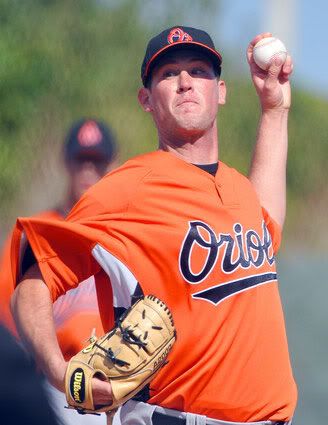Keith Law appeared on
the Fan with Jeremy Conn's Playmakers tonight to talk about prospects on the Orioles.
On Matt Wieters:
Law said he was not surprised that Wieters needed time to adjust. Few players come out and perform when they hit the big leagues . . . there are few Ryan Brauns. He thinks he will be a star by 2012 and 2013 when the Orioles will be ready to compete in the AL East.
Thoughts on the Orioles not signing a big name this offseason:
Law said he has been a supporter of Andy MacPhail devoting money to the minors leagues and developmental system. You won't win by trying to outspend the Yankees and Red Sox. The GM needed patience for the system to replenish itself and prepare them to having waves of talent rising up every year. In a year or two guys like Wieters, Jones, Reimold, and Matusz will be performing at a high level. A year or two after that another wave of talent will arrive in the form of guys like Britton and Joseph. Then another wave will come with guys like Hobgood, Coffey, and others.
On Brian Matusz:
Matusz is a player who was not going to develop in the minors. He secondary pitches are very good and overmatched HiA and AA batters. Add that to an above average fastball and it was clear that he would need to develop in the majors. The only aspect of his game that needs work is fastball command. When he solidifies that he will profile as a no. 2 starter or even as an unconvential no. 1 starter. He has a David Cone style approach where he uses his secondary pitches against both right handers and left handers to set them up on his fastball.
On Zach Britton:
Law is high on Zach Britton. He is a traditional sinker/slider pitcher with a good slider and a plus sinker. He uses these quite well to miss bats and induce groundballs. He should be able to be a top of the rotation pitcher. The high grade (no. 25) in this year's rankings is in large part due to his improving changeup which makes him more of a threat to batters on both sides of the plate. Law then talked about how he talked to three scouts who each said he was one of the best if not the best pitcher they watched all season. They gave very high praise including one who joked with Law not to place him too high on the list because he is trying to talk his GM in trading for him. Law mentioned that that won't happen as the Orioles are high on him as well. It may take about a year and half more development, but if Britton cuts down on his walks and improves the changeup he could be very special.
On Josh Bell:
Bell needs some developmental time. He has one of the best left handed swings in the minors, but his right handed approach needs a lot of work. His defense is a work in progress. His feet and athleticism are there, so Law thinks he can make it. He views the Dodgers system as one where players do not get a high level of instruction and that the Orioles do a better job of that. He thinks Bell is good enough that it would have been foolish for the Orioles to lock themselves in place with a 3 to 4 year deal at the corners and block Bell.
On Brandon Snyder:
The big question is if Snyder will have enough power. His swing is very nice, but it has never produced any power. His defense is solid at first, too. The power needs to show up if the Orioles are going to slot him in at first. If he does start hitting home runs he will clearly be an everyday player.
Jake Arrieta
Law sees him as a fourth starter, but mentions that the O's brass think higher of him than that. He has improved his control, which was the big knock on him. The consensus from scouts is that he is a 4th starter and that is not a bad thing as there are several pitchers in the pipeline that will challenge him for a slot in the rotation.
On Chris Tillman:
He looks light a number 2 pitcher, but has more development to go. The Orioles were somewhat forced to promote him before he was ready and will need to do that development in the majors. His curve has good depth on his curve and he has a good body. His command needs improvement. Very high potential.
bergesen
Law thinks Bergesen is a bottom of the rotation type of pitcher. He does not miss enough bats, but he does work down in the zone so that minimizes the damage of batted balls. His main role on the team will wind up being someone who can hold a rotation position warm on the cheap until another arm pushes him out of the way. He could be a 5th or possibly a 4th starter on a good team.




 Mike Montgomery, LHP, Kansas City Royals
Mike Montgomery, LHP, Kansas City Royals Garrett Richards, RHP, Houston Astros
Garrett Richards, RHP, Houston Astros Mike Moustakas, 3B, Kansas City Royals
Mike Moustakas, 3B, Kansas City Royals


 1. Brian Matusz LHSP A
1. Brian Matusz LHSP A 6. Brandon Snyder 1B B-
6. Brandon Snyder 1B B-